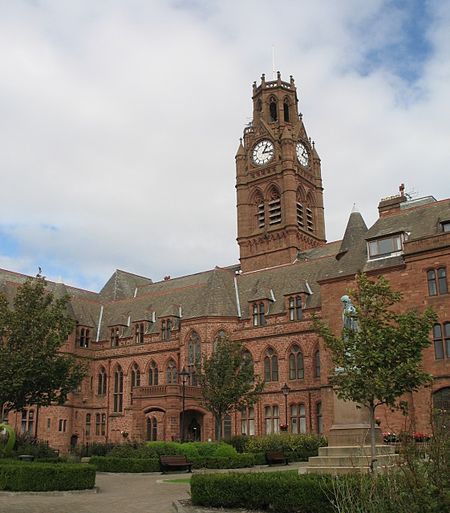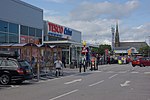Barrow-in-Furness is a port town in Cumbria, England. Historically in Lancashire, it was incorporated as a municipal borough in 1867 and merged with Dalton-in-Furness Urban District in 1974 to form the Borough of Barrow-in-Furness. At the tip of the Furness peninsula, close to the Lake District, it is bordered by Morecambe Bay, the Duddon Estuary and the Irish Sea. In 2011, Barrow's population was 56,745, making it the second largest urban area in Cumbria after Carlisle. Natives of Barrow, as well as the local dialect, are known as Barrovian.In the Middle Ages, Barrow was a small hamlet within the parish of Dalton-in-Furness with Furness Abbey, now on the outskirts of the town, controlling the local economy before its dissolution in 1537. The iron prospector Henry Schneider arrived in Furness in 1839 and, with other investors, opened the Furness Railway in 1846 to transport iron ore and slate from local mines to the coast. Further hematite deposits were discovered, of sufficient size to develop factories for smelting and exporting steel. For a period of the late 19th century, the Barrow Hematite Steel Company-owned steelworks was the world's largest.Barrow's location and the availability of steel allowed the town to develop into a significant producer of naval vessels, a shift that was accelerated during World War I and the local yard's specialisation in submarines. The original iron- and steel-making enterprises closed down after World War II, leaving Vickers shipyard as Barrow's main industry and employer. Several Royal Navy flagships, the vast majority of its nuclear submarines as well as numerous other naval vessels, ocean liners and oil tankers have been manufactured at the facility.
The end of the Cold War and subsequent decrease in military spending saw high unemployment in the town through lack of contracts; despite this, the BAE Systems shipyard remains operational as the UK's largest by workforce (9,500 employees in 2020) and is now undergoing a major expansion associated with the Dreadnought-class submarine programme. Today Barrow is also a hub for energy generation and handling. Offshore wind farms form one of the highest concentrations of turbines in the world, including the second largest offshore farm, with multiple operating bases in Barrow.






